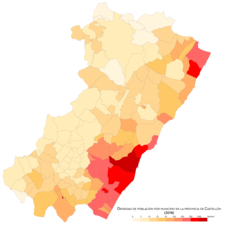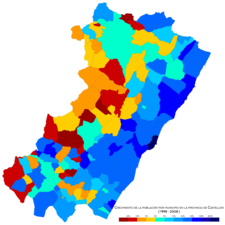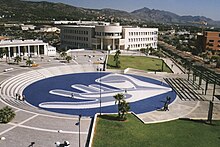Castellon Province
Castellón (co-officially in Valencian, Castelló) is a province in eastern Spain. It is located in the northernmost part of the Valencian Community and its capital is Castellón de la Plana. It has a population of 579,962 inhabitants (INE 2019) and a total of 135 municipalities.
Located in the east of the Iberian Peninsula, it borders the Mediterranean Sea to the east, and the provinces of Tarragona to the northeast, Teruel to the west and Valencia to the south. Its coast receives the tourist name of Costa del Azahar.
Official name
In the Valencian Community the official name of the provinces is bilingual.
- Castellón is the official denomination in Spanish.
- Castelló is the official denomination in Valencia.
Country
The province of Castellón is divided into 135 municipalities, grouped into 8 regions. These are shown below with their respective population, area and population density data updated to 2020 and the capital of each of them is indicated:
| Comarca | Population | Extension | Density | Capital | |
|---|---|---|---|---|---|
| Castellano | Valencia | ||||
| Alcalatén | L'Alcalatén | 15 613 | 648,70 | 24,07 | Alcora |
| High School | L'Alt Maestrat | 6622 | 663,06 | 99.99 | Albocácer |
| Alto Mijares | L'Alt Millars | 3857 | 647,40 | 5,96 | Cirat |
| High Palance | L'Alt Palància | 23 966 | 965,15 | 24,83 | Segorbe |
| Under Masters | The Baix Maestrat | 82 437 | 1221.32 | 67.50 | Vinaroz |
| High plan | The High Plane | 256 455 | 957,20 | 267,92 | Castellón de la Plana |
| Ground floor | La Plana Baixa | 192 283 | 605,20 | 317,72 | Burriana |
| The Ports of Morella | Els Ports | 4357 | 903,90 | 4.82 | Morella |
| Total | 585 590 | 6611,93 | 88.56 | ||
Geography
The province is mountainous in its interior, where the foothills of the Iberian system make up the natural regions of Maestrazgo to the north and Sierra de Espadán to the south. In addition, between the two we find the Peñagolosa peak (which gives its name to the massif of the same name) and that with 1813 m s. no. m. It is the second highest peak in the Community. Other main heights in the province are Peña Salada (1,581 m a.s.l.), Pina (1,405 m a.s.l.), Encanadé (1,393 m a.s.l.) and Muela de Ares (1,318 m a.s.l.). The province has a narrow coastal area in which the Peñíscola peninsula, the Oropesa del Mar cape and the Almenara inlet stand out as geographical accidents. Most of the population lives in the coastal strip, while the mountainous interior is practically uninhabited.
The Sierra de Irta is also a mountainous massif (practically unaltered by human activity) that extends parallel to the coast for 15 km.
The native vegetation is characterized by Mediterranean-type pine forests and scrub, and the two most important rivers in the province are the Mijares and the Palancia.
The Columbretes Islands also belong to the province of Castellón, an uninhabited archipelago located 56 km from the coast.
The highest peak in the province is Penyagolosa.
It is important to note that the Greenwich Meridian passes through the province as an imaginary line and in Castellón it intersects with Parallel 40, the exact point is marked with a monolith and can be visited in the Parque del Meridiano.
Climate
The province's own Mediterranean climate is characterized by mild winters and warm summers. In the interior the temperatures are usually colder, with precipitations in the form of snow during the winter.
The average temperature of the province is 17 °C, and the average rainfall oscillates around 500 mm a year distributed irregularly in the autumn and spring months and with the classic Mediterranean summer drought. In inland mountainous areas, rainfall records are more abundant, exceeding 600 mm in many areas.
Natural parks
- Sierra de Irta
- Prat de Cabanes-Torreblanca
- Benifasar Trend
- Desert of the Palmas
- Peñagolosa
- Sierra de Espadán
- Columbretes Islands
- Sierra Calderona
History
From the 8th century to the first third of the 13th century, the province was in Muslim hands. Jaime I the Conqueror took it from the Arab kings of Valencia and incorporated it into the Crown of Aragon: the first place to be conquered was Ares del Maestre, in the year 1232, and the following year Peñíscola and Fadrell Castle (in the current Castellón de la Plana).
A small area in the southern part of the interior was repopulated mainly by Aragonese, hence the traditional language of this area is Spanish, while on the coast and the rest of the interior the repopulation of Catalan origin predominated, therefore that Valencian is the traditional language of those areas.
During the Carlist wars, the Maestrazgo region (in the north of the province) was a continuous reactionary focus, while the capital occupied a prominent place as a point of support for the liberal Elizabethan armies.
Population
The population density of the province of Castellón is 87.25 inhab/km² (INE 2019), slightly lower than the Spanish average (92.02 inhab/km²) and the lowest of the three provinces of the Valencian Community, it also represents 1.25% of the demographic percentage with respect to the state total and 11.79% with respect to the regional total.
| Graphic of demographic evolution of the province of Castellón between 1857 and 2020 |
 |
Source: Spanish National Statistical Institute - Graphical development by Wikipedia. |
| Position | Municipality | Population |
|---|---|---|
| 1. a | Castellón de la Plana | 171.857 |
| 2. a | Villarreal | 51.369 |
| 3. a | Burriana | 35.019 |
| 4. a | Vall de Uxó | 31.388 |
| 5. a | Vinaroz | 29.120 |
| 6. a | Benicarló | 27.780 |
| 7. a | Almazora | 27.383 |
| 8. a | Onda | 25.099 |
| 9. a | Benicasim | 19.507 |
| 10. a | Nules | 13.449 |
| 11. a | Alcora | 10.468 |
| 12. a | Oropesa del Mar | 10.184 |
| 13. a | Segorbe | 9.146 |
| 14. a | Peñíscola | 8.210 |
| 15. a | Moncofar | 7.338 |
| 16. a | Alcalá de Chivert | 6.831 |
| 17. a | Almenara | 6.388 |
| 18. a | Bechí | 5.587 |
| 19. a | Borriol | 5.749 |
| 20. a | Torreblanca | 5.682 |
| Demographic developments in the province of Castellón and percentage compared to national total | |||||||||||||||||||
|---|---|---|---|---|---|---|---|---|---|---|---|---|---|---|---|---|---|---|---|
| 1857 | 1887 | 1900 | 1910 | 1920 | 1930 | 1940 | 1950 | 1960 | |||||||||||
| Population | 260 919 | 292 437 | 310 828 | 322 213 | 306 886 | 308 746 | 312 475 | 325 091 | 339 229 | ||||||||||
| Percentage | 1.69% | 1.66% | 1.67% | 1.61% | 1.43% | 1.30% | 1.20% | 1.16% | 1.11% | ||||||||||
| 1970 | 1981 | 1991 | 1996 | 2000 | 2005 | 2010 | 2015 | 2019 | |||||||||||
| Population | 385 823 | 431 755 | 448 182 | 456 727 | 474 385 | 543 432 | 604 274 | 582 327 | 579 962 | ||||||||||
| Percentage | 1.14% | 1.14% | 1.14% | 1.15% | 1.18% | 1.25% | 1.28% | 1.25% | 1.23% | ||||||||||
It has a population of 579,962 inhabitants (INE 2019) which is distributed very unevenly: the vast majority are in Castellón de la Plana (29.62% of the provincial population) and its metropolitan area, that is, in the southeast quadrant of the province. The northern coastal strip of Castellón also has significant concentrations of population (Vinaroz - Benicarló). However, the interior, mountainous, is very sparsely populated, since 17 localities do not reach 100 inhabitants. After the capital, the most populated municipalities in the province (with more than 20,000 inhabitants according to the INE 2019 census) are: Villarreal, Burriana, Vall de Uxó, Vinaroz, Benicarló, Almazora and Onda.
According to the 2015 INE census, 17.6% of the provincial population was of foreign nationality, some six and a half points above the national average.
| Country | Population |
|---|---|
| 42 458 | |
| 16 377 | |
| 3812 | |
| 2298 | |
| 1703 | |
| 1471 | |
| 1420 | |
| 1372 | |
| 1207 | |
| 1167 |
The province of Castellón is the 26th in Spain in which there is a higher percentage of inhabitants concentrated in its capital (29.62%, compared to 31.96% for the whole of Spain).
Economy
The industry in Castellón has traditionally stood out for the collection of citrus fruits and vegetables (Burriana, Nules and Benicarló). It should be noted that in the province of Castellón most of the Spanish industrial sector is concentrated in the ceramic and tile industry (Onda, Alcora, Nules, Castellón and Villarreal) and furniture manufacturing (Benicarló and Vinaroz). Several important multinationals in the chemical sector (Factories in Benicarló and Castellón), the classic footwear industries (Vall de Uxó), fishing (Castellón, Vinaroz, Benicarló), or textiles (Vilafranca and Morella), have gradually given way to a constant outsourcing of the productive sectors due to the constant increase in the weight of tourism in the economy of the province.
Administration and politics
The government and administration of the province corresponds to the Provincial Council of Castellón, in accordance with the provisions of article 141 of the Constitution. Its composition is established by indirect election based on the results of the municipal elections. Between 2011 and 2019 it was chaired by Javier Moliner Gargallo, a member of the Popular Party. Since 2019 the president is Josep Pasqual Martí García, from the Socialist Party of the Valencian Country (PSPV-PSOE).
Civil government
However, from the Cortes of Cádiz in 1812, the legal figure of the Civil Governors arose to assume the functions of government in each province, so that during the Franco regime this figure was strengthened as the body of maximum political authority. administrative, government representative and coordinator of provincial administration services, as well as head of public order and police services.
With the development of the Autonomies this figure has been losing powers, until in 1996 it disappeared to create the figure of the Government sub-delegation, remaining only as an administrative unit that represents the central government in the province. Since 2012, the holder of the position corresponds to David Barelles Adsuara.
Services
Transportation
Roads
The province of Castellón is connected by highways or conventional highways with the neighboring provinces and has the following roads that connect it with the rest of Spain:
- AP-7 Mediterranean motorway: national highway crossing the province of Castellón from Valencia to Tarragona, Barcelona and France.
- A-7 Mediterranean motorway: the only section of this road that exists in the province is the unfolding from the N-340 between Almenara and Nules. Then, between Nules and Castellón, the route where it changes to the CV-13 denomination until it ends in Torreblanca.
- CV-10 Autovía de la Plana: continuation of the A-7 from Villavieja, where it passes to the hands of the Valencian Generality, to Benlloch.
- CV-13 Benlloch-Torreblanca: continuation of CV-10 from Benlloch to Torreblanca. In the stretch that goes from the airport of Castellón (Villanueva de Alcolea) to Torreblanca the road passes from the road to the conventional road.
- A-23 Autovía Mudéjar: national motorway starting in Sagunto (Valencia) but between Algimia de Alfara and Barracas crossing the south of the province of Castellón.
- A-68 Autovía del Ebro: a motorway project that is not yet known if you will arrive in the Mediterranean by Reus and Tarragona or by Morella and Vinaroz. Currently, the section closest to the province runs between Zaragoza and El Burgo de Ebro, more than 150 km from Morella.
- N-340 Mediterranean National Highway: National road parallel to the AP-7, which enters the province of Castellón through the A-7 but then forks. It crosses the entire province as well as all coastal municipalities (Villarreal, Nules, Benicásim, Oropesa del Mar, Vinaroz, among others).
- N-225 Teruel-Grao de Castellón: national road that, in the province of Castellón, is divided into several sections. The most important is the one that connects Vall de Uxó with the A-23, thus attacking several kilometers of the A-7. The other section has been unfolded and converted into a motorway (CS-22, which connects the N-340 with the Port of Castellón).
- N-232 Carretera de Vinaroz a Santander: historical connection of the province of Castellón with Zaragoza and the north of the Peninsula. This would be the trace if finally the A-68 communicates with the Mediterranean for Vinaroz.
- Other routes of less importance: from the coast, there are a number of roads that communicate with the interior and, in this case, the provinces of Valencia and Teruel. It's autonomic roads.
Railway
Two railway lines cross the province of Castellón. From north to south, the line of the Mediterranean arc, which joins Barcelona with Valencia, and in the Alto Palancia region, the Sagunto-Zaragoza line.
The commuter trains from Valencia arrive on the C-5 to Caudiel, and on the C-6 to Vinaroz.
Air transportation
The Castellón-Costa Azahar Airport was built, with the intention of providing the province of Castellón with means capable of making the great leap to major communications in order to promote and link provincial tourism to the rest of the Peninsula and Europe. It cost more than 150 million euros. Despite having been officially inaugurated in March 2011, it did not receive all the permits to operate until December 2014, and until September 2015 it lacked regular operations, becoming an international symbol of waste that characterized the development of the Spanish crisis of 2008-2016.
As of July 2019, the aerodrome has two active regular lines, London (United Kingdom) and Bucharest (Romania), and three lines that operate only in the summer period: Sofia (Bulgaria), Budapest (Hungary) and Katowice (Poland).
Health
Castellón has six public hospitals, managed by the Valencian Health Agency. All of them are publicly managed hospitals, except the Provincial one, which acts as a Consortium:
- Hospital Comarcal de Vinaroz
- Hospital Complementario Alto Palancia (Segorbe)
- Hospital General Universitario de Castellón
- Hospital la Magdalena (Castellón de la Plana)
- Provincial Hospital of Castellón (Consortium Provincial Hospital of Castellón)
- Hospital Universitario de la Plana (Villarreal)
The healthcare offer is also complemented by a private hospital, outside the social security service, located in Castellón de la Plana, the Hospital Rey Don Jaime.
Education
The province has a public university and a campus of one, both located in the city of Castellón.
- The Universidad Jaime I (UJI) was founded in 1991. It offers more than thirty degrees and studies more than 14 000 students annually.
- CEU Cardenal Herrera University (CEU-UCH), is a private university that has one of its campuses in the city of Castellón.
Tourism
In the province of Castellón you can go from the sea to the high mountains in a few kilometers; The classic sun and beach tourism (Benicasim, Oropesa del Mar, Vinaroz, Burriana, Peñíscola, Benicarló, etc.) is complemented by a thriving inland tourism of rural houses, with the monumentality of towns such as Morella, San Mateo, Segorbe, spas in Montanejos, Benasal, Catí, the springs of the Palancia river, a wide network of trails, hermitages...
Peñíscola, baptized as the city in the sea, has more than 50% of the hotel beds in the province and is the third tourist destination in the Valencian Community after Benidorm and Valencia.
There are also a large number of landscapes and natural sites throughout the province such as the Grottos of San José in the Vall de Uxó, castles such as Peñíscola, Morella, or the fortified town of Mascarell, Roman remains de Benicató and religious architecture in Nules, Iberian settlements such as Puig de Benicarló, modernist houses in Burriana and Vinaroz, tourist centers such as Marina d'Or and La Renegá (both in Oropesa del Mar), the peculiar El Fadrí in Castellón de la Plana, the Entrance of bulls and horses in Segorbe, or the Cartuja de Vall de Cristo and the Sanctuary of the Holy Cave in Altura (patron saint of the province).
Notable people
Contenido relacionado
Azerbaijan
Tongan flag
Vigo











